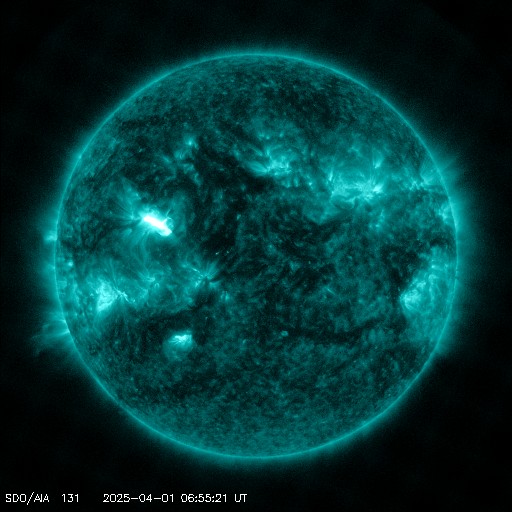Viewing archive of Friday, 29 November 2002
Solar activity report
Any mentioned solar flare in this report has a scaling factor applied by the Space Weather Prediction Center (SWPC). Because of the SWPC scaling factor, solar flares are reported as 42% smaller than for the science quality data. The scaling factor has been removed from our archived solar flare data to reflect the true physical units.
Report of Solar-Geophysical Activity 2002 Nov 29 2200 UTCPrepared by the NOAA © SWPC and processed by SpaceWeatherLive.com
Joint USAF/NOAA Report of Solar and Geophysical Activity
SDF Number 333 Issued at 2200Z on 29 Nov 2002IA. Analysis of Solar Active Regions and Activity from 28-2100Z to 29-2100Z
Solar activity was low during the past 24 hours. Only
two C-class flares were observed, both from Region 207 (S19E44). The
largest was a C3 at 28/2244 UTC. Region 207 is the largest region on
the disk, but has a relatively simple magnetic configuration. New
Region 208 (N10E74) rotated into view today as a simple D-type
group. A CME was observed to erupt off the south pole at 0054 UTC,
but the lack of corresponding disk signatures suggests that this was
a back-sided event.
IB. Solar Activity Forecast
Solar activity is expected to be
mostly low during the next three days. There is a chance, however,
for an isolated M-class event, with Region 207 the most likely
source region.
IIA. Geophysical Activity Summary 28-2100Z to 29-2100Z
The geomagnetic field was mostly quiet to unsettled, with a few
active periods. Solar wind velocity remains enhanced and the
interplanetary magnetic field continues to have significant
intervals of weakly southward orientation. The greater than 2 MeV
electron fluxes reached high levels during the past 24 hours.
IIB. Geophysical Activity Forecast
The geomagnetic field is
expected to be unsettled to active for the next three days, with a
chance for some isolated storm intervals. The increase is predicted
because of expected effects from a high speed solar wind stream
associated with a favorably positioned coronal hole.
III. Event Probabilities 30 Nov to 02 Dec
| Class M | 25% | 25% | 25% |
| Class X | 01% | 01% | 01% |
| Proton | 01% | 01% | 01% |
| PCAF | green | ||
IV. Penticton 10.7 cm Flux
Observed 29 Nov 141 Predicted 30 Nov-02 Dec 140/145/155 90 Day Mean 29 Nov 171
V. Geomagnetic A Indices
Observed Afr/Ap 28 Nov 010/015 Estimated Afr/Ap 29 Nov 010/015 Predicted Afr/Ap 30 Nov-02 Dec 015/015-015/015-015/020
VI. Geomagnetic Activity Probabilities 30 Nov to 02 Dec
| A. Middle Latitudes | |||
|---|---|---|---|
| Active | 45% | 45% | 45% |
| Minor storm | 15% | 15% | 15% |
| Major-severe storm | 10% | 10% | 10% |
| B. High Latitudes | |||
|---|---|---|---|
| Active | 35% | 35% | 35% |
| Minor storm | 25% | 25% | 25% |
| Major-severe storm | 15% | 15% | 15% |
All times in UTC
Latest news
Latest forum messages
Temporary Topic - Ongoing Solar Proton Events 6Similar AR 3664 vs AR 4048 ??? 10We are launching a dating app! SpaceWeatherLove! Download it today! 1Growth of Cycle 25 825AR4048 62
More topicsSupport SpaceWeatherLive.com!
A lot of people come to SpaceWeatherLive to follow the Sun's activity or if there is aurora to be seen, but with more traffic comes higher server costs. Consider a donation if you enjoy SpaceWeatherLive so we can keep the website online!

Latest alerts
07:15 UTC - 10cm Radio Burst
Begin Time: 01/04/2025 06:45 UTC Maximum Time: 01/04/2025 06:45 UTC Duration: 1 minutes. Peak flux: 190 sfu
07:06 UTC - Solar flare
Strong M5.61 flare
06:48 UTC - Radio Blackout
Moderate R2 radio blackout in progress (≥M5 - current: M5.36)
06:45 UTC - Radio Blackout
Minor R1 radio blackout in progress (≥M1 - current: M1.7)
02:15 UTC - Solar protons
Moderate S2 Solar Radiation Storm - Infrequent effects on HF radio through polar regions and satellite operations
Space weather facts
| Last X-flare | 2025/03/28 | X1.1 |
| Last M-flare | 2025/04/01 | M5.6 |
| Last geomagnetic storm | 2025/03/27 | Kp5 (G1) |
| Spotless days | |
|---|---|
| Last spotless day | 2022/06/08 |
| Monthly mean Sunspot Number | |
|---|---|
| February 2025 | 154.6 +17.6 |
| Last 30 days | 128.5 -22.7 |



